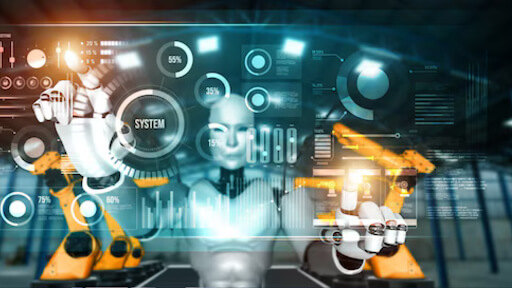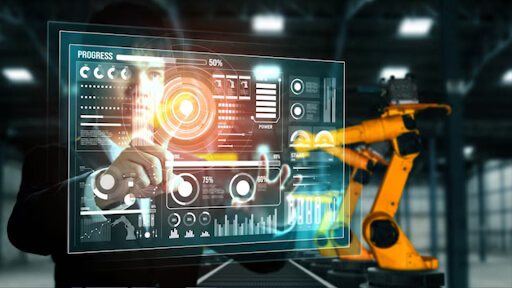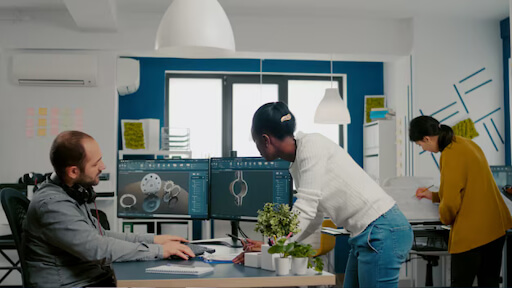 1-800-805-5783
1-800-805-5783 
Automation is revolutionizing industries, enhancing efficiency, and driving cost savings. However, its full potential is realized only when designed with a human-centered approach that prioritizes usability, collaboration, and augmentation rather than replacement.
The transition from Industry 4.0, focused on full automation, to Industry 5.0, which emphasizes human-machine synergy, marks a significant shift in how technology is developed and deployed. Rather than making human labor obsolete, the goal is to empower workers with intelligent tools that improve decision-making, reduce repetitive tasks, and enhance overall productivity.
Consider Japan’s manufacturing sector: companies like Fanuc and Universal Robots are integrating collaborative robots (cobots) into production lines. These robots don’t replace workers but instead assist them in performing precise and labor-intensive tasks, reducing fatigue and improving efficiency without job displacement. This model represents the essence of human-centered automation—technology that enhances human potential rather than diminishing it.
A PwC study projects that AI and automation could contribute $15.7 trillion to the global economy. The challenge is ensuring that this transformation is equitable, ethical, and human-focused and preventing the unintended consequences of job losses and alienation.
Automation has long been driven by maximizing efficiency by minimizing human intervention, a hallmark of Industry 4.0. However, this approach often led to job displacement, skill redundancy, and resistance to adoption as workers feared being replaced by machines.
Industry 5.0 focuses on human-machine collaboration, where automation enhances human skills rather than eliminating roles. For example, BMW’s factories use collaborative robots (cobots) to assist in assembly tasks, reducing strain on workers while improving precision and efficiency.
Similarly, in healthcare, AI-powered diagnostic tools like Siemens Healthineers AI-Rad Companion enhance radiological analysis by detecting patterns and highlighting abnormalities, helping radiologists focus on complex cases. By prioritizing usability, adaptability, and workforce integration, companies can ensure automation works for people, not against them.

To ensure automation enhances human capabilities, it must be designed with key human-centered principles:
By following these principles, businesses can create efficient, ethical, and user-friendly automation.

Human-centered automation revolutionizes industries by integrating intelligent systems with human expertise, ensuring efficiency while maintaining usability, adaptability, and trust. Here are some key sectors where this approach is making a significant impact:
AI-powered automation assists, not replaces, healthcare professionals. For instance, Google’s DeepMind Health (MedPaLM 2) AI model assists doctors in medical diagnosis by analyzing patient data, medical literature, and imaging results with near-human accuracy. It improves decision-making without replacing clinicians.
Similarly, AI-driven robotic surgical assistants, such as the da Vinci Surgical System, provide precision and reduce surgeon fatigue, improving patient outcomes without eliminating human expertise.
Traditional industrial robots were designed to replace human labor, but modern collaborative robots (cobots) work alongside humans. Companies like BMW, Ford, and Tesla integrate cobots to assist in assembly lines, handling repetitive or physically demanding tasks while workers focus on quality control and problem-solving.
Research shows that workplaces using cobots report a 50% increase in efficiency while improving worker safety and reducing fatigue-related errors.
Retail automation is enhancing customer interactions without sacrificing personalization. AI-powered chatbots and virtual assistants handle routine inquiries, order tracking, and FAQs, reducing response times by 37%.
However, complex issues are still escalated to human agents, ensuring empathy and contextual understanding in customer support. Personalized recommendation engines, like Amazon’s AI-driven suggestions, blend automation with human buying behavior, contributing 35% to its sales.
Automation in banking streamlines fraud detection and financial advising, but human oversight remains essential. AI methods, including anomaly detection and natural language processing, outperform traditional auditing techniques by approximately 15–30% in fraud detection accuracy.
However, flagged cases still require human auditors to prevent false positives. Additionally, AI-driven robo-advisors, such as Betterment and Wealthfront, provide automated investment advice but allow users to consult human financial experts when needed.
The logistics sector leverages automation to improve route optimization, inventory management, and supply chain efficiency. AI-powered fleet management tools predict vehicle maintenance needs, reducing breakdowns by 20%. In warehouses, companies like Amazon and DHL use robotic sorting systems, which boost efficiency but still require human workers for decision-making and quality control.

A human-centered approach to automation ensures technology enhances human potential rather than replaces it, leading to tangible benefits across industries:
When AI and automation handle repetitive tasks, employees can focus on higher-value work. A report found that businesses adopting human-centered automation saw a 25% improvement in workforce efficiency, as workers spent more time on strategic decision-making than manual operations.
Employees are more likely to embrace automation when it aligns with their workflows. Amazon’s fulfillment centers, for instance, use AI-driven robotics that enhances workers’ speed without making them redundant, improving morale and engagement.
AI-driven automation can minimize human errors, particularly in data-heavy sectors like finance and healthcare. AI-assisted medical imaging has reduced diagnostic errors when used alongside radiologists. In fraud detection, AI models detect anomalies more accurately, but human auditors provide contextual verification to prevent false positives.
Automation should not lead to mass job losses but rather job transformation. Companies investing in employee upskilling and AI training demonstrate how businesses can integrate automation while empowering employees with new skills.
By designing automation that works with and for people, industries can increase efficiency, foster innovation, and maintain workforce trust—a sustainable approach to digital transformation.
Automation is shifting from full autonomy to intelligent augmentation, where AI assists rather than replaces humans. Future AI systems will provide real-time insights, adapt to user behavior, and personalize experiences based on individual workflows.
As AI adoption grows, ethical considerations and regulatory frameworks will shape its development. Businesses investing in explainable, user-friendly automation will foster trust, improve adoption, and drive sustainable innovation, ensuring humans and technology evolve together.

Human-centered automation ensures technology empowers people, not replaces them. Businesses can drive efficiency, trust, and innovation by prioritizing usability, ethics, and collaboration. The future lies in humans and machines working together, balancing AI’s capabilities with human intuition for sustainable growth.
[x]cube LABS’s teams of product owners and experts have worked with global brands such as Panini, Mann+Hummel, tradeMONSTER, and others to deliver over 950 successful digital products, resulting in the creation of new digital revenue lines and entirely new businesses. With over 30 global product design and development awards, [x]cube LABS has established itself among global enterprises’ top digital transformation partners.
Why work with [x]cube LABS?
Our co-founders and tech architects are deeply involved in projects and are unafraid to get their hands dirty.
Our tech leaders have spent decades solving complex technical problems. Having them on your project is like instantly plugging into thousands of person-hours of real-life experience.
We are obsessed with crafting top-quality products. We hire only the best hands-on talent. We train them like Navy Seals to meet our standards of software craftsmanship.
Eye on the puck. We constantly research and stay up-to-speed with the best technology has to offer.
Our CI/CD tools ensure strict quality checks to ensure the code in your project is top-notch.
Contact us to discuss your digital innovation plans, and our experts would be happy to schedule a free consultation.